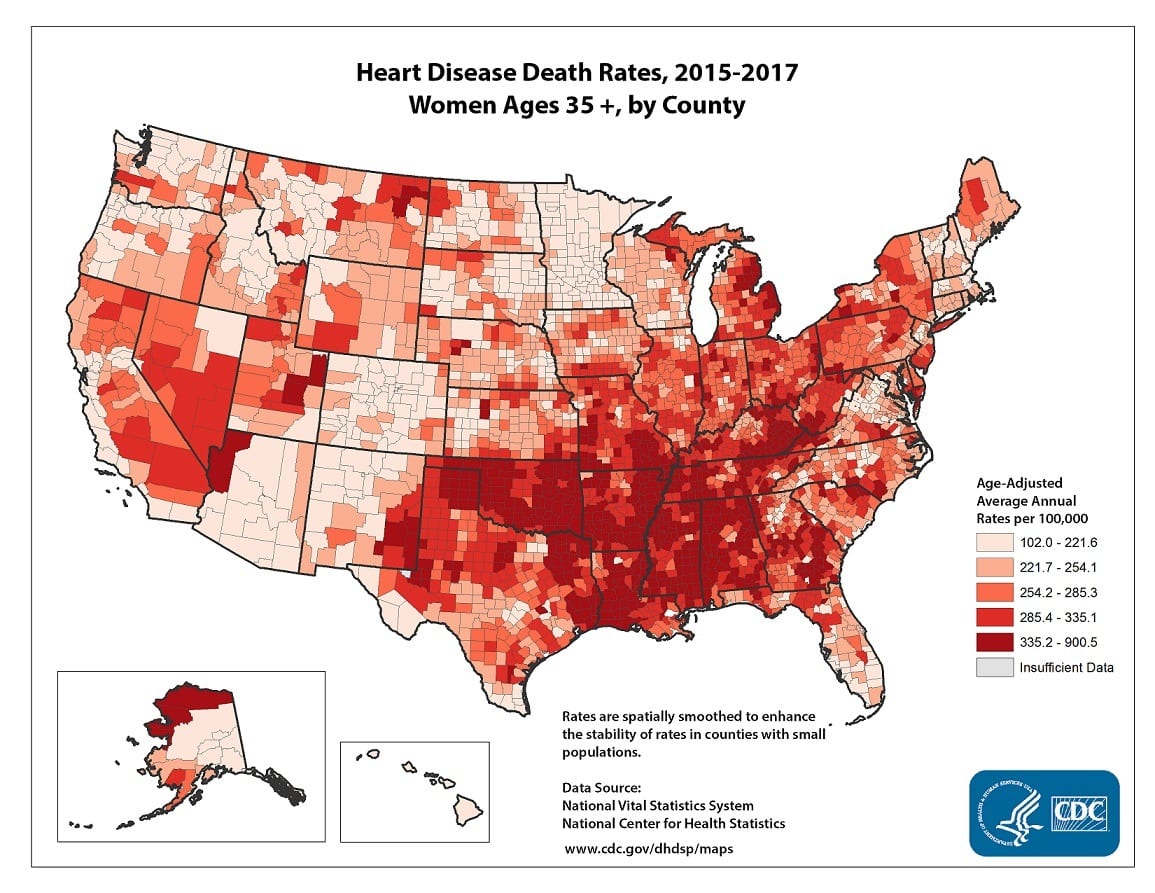Women and Heart Disease: US statistics
Jan 12, 2025
Introduction: Ignoring the Silent Killer
More women in the United States die from heart disease every single year than from all cancers combined, yet for far too long, society has ignored this haunting reality. Shockingly, millions of American women remain unaware that heart disease is not merely a men’s issue; it is their number one killer. The implications are staggering: despite a growing body of research, risk factor awareness campaigns, and the sheer volume of women’s lives lost to cardiovascular complications, the collective consciousness too often focuses on other health threats.
Meanwhile, an alarming racial gap is also revealed in maternal mortality statistics, especially for Black women, who are multiple times more likely to die from pregnancy-related causes than white women. This disparity underscores the depth of our healthcare inequalities and the urgent need for a multifaceted revolution in women’s health. Heart disease is not a distant spectre that only affects the elderly or the unlucky;, its seeds are planted early and, left unaddressed, can flourish long before any stark warning signs surface. The time to speak boldly and act decisively is now because every woman deserves the chance to understand her vulnerability, defend her health, and demand the life-saving care that all people—in every corner of the nation—deserve.

The Breast Cancer Paradox
For decades, heart disease was seen by many as a malady that primarily afflicted older men. That misguided assumption persisted in mainstream culture, medical research, and even among some healthcare professionals, stunting public awareness programs that might otherwise have spared countless women’s lives. Rather than zeroing in on their personal risk, many women found themselves preoccupied with breast cancer—a frightening condition, no doubt—which, year after year, has benefited from vast awareness campaigns, official months, pink ribbons, and robust philanthropic efforts. Although attention to breast cancer remains crucial, national data shows that heart disease kills over 300,000 women annually in the United States alone. Put differently, one out of every five female deaths is tied to a failing heart.
This jaw-dropping reality does not align with the common assumptions that swirl around women’s health. The reasons for this disconnect are many. Breast cancer can strike a woman in her 30s or 40s, often with symptoms that are more physically and psychologically visible. A breast cancer diagnosis may be accompanied by changes in body image, sexuality, and self-esteem, making it viscerally immediate and, therefore, prominent in everyday conversations. Heart disease, on the other hand, has a silent, stealthy progression. Its earliest sign often fails to register, especially in younger women, who may presume they remain safe until after menopause or old age. By the time warning bells ring—perhaps in the form of high blood pressure, chest discomfort, or shortness of breath—they may already be facing severe complications since the disease has quietly attacked their cardiovascular system for years, if not decades.
The Gender Bias Epidemic
Adding to the complexity is the alarming fact that many physicians do not thoroughly discuss coronary risk with women in the same way they do with men, and some of them even misinterpret women’s heart-related symptoms, attributing them to panic attacks, stress or hormonal fluctuations. Even though medical guidelines have evolved, and more providers highlight the importance of comprehensive cardiac evaluations, the gap in care remains significant.
In addition, women may brush aside subtle symptoms, carrying on with their hectic schedules—juggling work, children, family, and other obligations—until something goes catastrophically wrong. This combination of reduced awareness, lukewarm prioritization, and overlooked treatments reveals just how dangerous the situation is for women nationwide. Given that heart disease kills more women than all forms of cancer combined, it is an outrage that such a small fraction of women identify it as the top threat to their health. Only about half even recognize heart disease as their number one killer. When asked about personal health worries, a shockingly low percentage single out heart disease, letting the spectre of breast cancer overshadow what may be an even graver menace.
Risk Factors: The Hidden Danger
But let there be no illusions: heart disease is as much a woman’s problem as a man’s problem—if not more so, given the long history of underestimation and gender bias in research and treatment. Coronary heart disease is the leading cause of heart attacks in both sexes, a condition spurred by cholesterol-laden plaque that clogs arteries over time.
These blockages often start forming in childhood, fed by poor diets, sedentary habits, and other risk factors that build up throughout one’s life. When the heart’s arteries get narrowed or a plaque deposit ruptures, the blood supply to the heart muscle itself is compromised, culminating in a heart attack. Certain risk factors—like genetics, age, and family history—are out of any single individual’s control, but many more can be controlled or alleviated through deliberate action. High blood pressure, an unhealthy diet, smoking, obesity, and uncontrolled diabetes are the heavy hitters that increase a woman’s chance of experiencing a heart attack in her lifetime.
Furthermore, having multiple risk factors at once compounds the dangers. An overweight or obese individual who smokes and wrestles with high blood pressure is far more likely to encounter heart disease or stroke down the road. It is in the realm of these modifiable risk factors that major opportunities exist for preventing heart disease in women, well before it becomes a life-altering health crisis.
The Silent Killer in Women’s Lives
More women in the United States die from heart disease every single year than from all cancers combined, yet for far too long, society has ignored this haunting reality. Shockingly, millions of American women remain unaware that heart disease is not merely a men’s issue; it is their number one killer. The implications are staggering: despite a growing body of research, risk factor awareness campaigns, and the sheer volume of women’s lives lost to cardiovascular complications, the collective consciousness too often focuses on other health threats.
Heart Disease: The Invisible Epidemic Among Women
Meanwhile, an alarming racial gap is also revealed in maternal mortality statistics, especially for Black women, who are multiple times more likely to die from pregnancy-related causes than white women. This disparity underscores the depth of our healthcare inequalities and the urgent need for a multifaceted revolution in women’s health. Heart disease is not a distant spectre that only affects the elderly or the unlucky;, its seeds are planted early and, left unaddressed, can flourish long before any stark warning signs surface. The time to speak boldly and act decisively is now because every woman deserves the chance to understand her vulnerability, defend her health, and demand the life-saving care that all people—in every corner of the nation—deserve.
Misplaced Focus: Why Breast Cancer Awareness Overshadows
For decades, heart disease was seen by many as a malady that primarily afflicted older men. That misguided assumption persisted in mainstream culture, medical research, and even among some healthcare professionals, stunting public awareness programs that might otherwise have spared countless women’s lives. Rather than zeroing in on their risk, many women found themselves preoccupied with breast cancer—a frightening condition, no doubt—which, year after year, has benefited from vast awareness campaigns, official months, pink ribbons, and robust philanthropic efforts.
The Deadliest Disconnect: One in Five Women Succumb to Heart Disease
Although attention to breast cancer remains crucial, national data shows that heart disease kills over 300,000 women annually in the United States alone. Put differently, one out of every five female deaths is tied to a failing heart. This jaw-dropping reality simply does not align with the common assumptions that swirl around women’s health. Breast cancer can strike a woman in her 30s or 40s, often with symptoms that are more physically and psychologically visible. Heart disease, on the other hand, has a silent, stealthy progression.
Misdiagnosed, Overlooked, and Underestimated
Adding to the complexity is the alarming fact that many physicians do not thoroughly discuss coronary risk with women in the same way they do with men, and some even misinterpret women’s heart-related symptoms, attributing them to panic attacks, stress, or hormonal fluctuations. Even though medical guidelines have evolved, and more providers highlight the importance of comprehensive cardiac evaluations, the gap in care remains significant.
A Silent Crisis: The Dangerous Invisibility of Heart Disease Symptoms
Women themselves may brush aside subtle symptoms, carrying on with their hectic schedules—juggling work, children, family, and other obligations—until something goes catastrophically wrong. This combination of reduced awareness, lukewarm prioritization, and overlooked treatments reveals just how dangerous the situation is for women nationwide.
The Lifesaving Power of Prevention
Proactive prevention demands knowledge about heart health, regular checkups, and consistent communication with medical professionals. A woman who advocates for herself—requesting thorough cardiac evaluations and specialized tests—can uncover and address hidden threats early.
Small Changes, Big Impact: The Heart-Healthy Lifestyle Blueprint
Among the most impactful prevention strategies is adopting a heart-healthy lifestyle, which means committing to a balanced diet, regular exercise, weight management, and smoking cessation. Women can command greater influence over their long-term health by intentionally carving out space for stress management, meal planning, and physical activity.
The Maternal Mortality Crisis
Beyond these universal considerations, the story of Black women in America encountering both heart disease and maternal health crises is especially dire. While heart disease remains the top cause of death for all women, the journey for Black women is mired in systemic inequalities that manifest as higher rates of preeclampsia, eclampsia, and postpartum complications that can ultimately trigger heart failure.
Unmasking the Racial Divide: Why Black Mothers Face Higher Risks
The maternal mortality crisis stands as a profound example: Black women are three to four times more likely to die from pregnancy-related causes than white women, regardless of their income or educational attainment. Even high-profile celebrities like Beyoncé and Serena Williams, whose lives were saved through their own self-advocacy, underscore this deadly disparity.
Bridging the Gap: Systemic Changes for Women’s Health
This crisis highlights the deeply rooted flaws in the healthcare system. Addressing the racial disparities in maternal and heart health requires systemic change, beginning with better education for healthcare providers about implicit biases, more inclusive research studies, and equitable access to care. Policymakers must prioritize funding for community health initiatives, particularly in underserved areas, to ensure women of all backgrounds have access to preventive care and early intervention.
Advocacy and Awareness: Empowering Women to Demand Better
For individual women, empowerment begins with education and advocacy. Understanding the signs of heart disease—chest pain, shortness of breath, fatigue, or even less obvious symptoms like jaw pain or nausea—can be the difference between life and death. Women must feel empowered to ask questions, seek second opinions, and push for advanced testing if something feels wrong.
A Call to Action for Change
The tide is slowly turning. Campaigns like the American Heart Association’s “Go Red for Women” are shedding light on the dangers of heart disease in women. However, awareness must translate into action. The medical community needs to prioritize female-centric research and develop treatment protocols that reflect the unique ways heart disease manifests in women.
Investing in Women’s Health: A Lifesaving Imperative
Public health organizations must also expand their efforts, working with schools, workplaces, and communities to promote heart health from an early age. This means advocating for better nutrition programs, creating opportunities for physical activity, and addressing mental health challenges that often contribute to heart disease.
The Hopeful Horizon
While the challenges are immense, the opportunities for progress are equally significant. Every woman who learns about her risk, every healthcare provider who challenges outdated assumptions, and every policymaker who invests in women’s health brings us closer to a future where fewer lives are lost to preventable conditions.
The Power of Collective Action
The fight against heart disease in women requires a collective effort. From the individual level—where women take control of their health—to the systemic level, where policies and practices are reformed, each step forward saves lives. Together, we can ensure that heart disease is no longer the silent killer it has been for far too long.
Final Thoughts: Your Heart Matters
At its heart, this is a battle for survival, equality, and justice. Every statistic represents more than a data point: it personifies a life ended prematurely, a family shattered, a community robbed of a mother, daughter, sister, or friend who might have lived and thrived with timely interventions.
By being bold in our approach—talking fearlessly about the uncomfortable truths, describing heart disease in vivid, uncompromising terms, and calling out systemic inequities at every level—we can reorient the conversation about women’s health in America. We can challenge the biases and relegate these deadly disparities to history books where they belong. Yes, women’s hearts deserve vigilance, research, and respect, but first, they deserve recognition. So let us take these facts and own them, let us learn from them, and let us demand better.
The fight for women’s heart health is not an afterthought or a niche topic; it’s a formidable front line in a broader struggle for women’s well-being, autonomy, and the ability to lead full, unencumbered lives. With enough collective courage and relentless insistence on change, we will look back one day and see the turning point where society finally addressed America’s leading female killer—and refused to settle for anything less than Victor
The Way of Wisdom: Charting a Meaningful Path













